Analysis of Licensing Proprietary Technology in Business Strategy
VerifiedAdded on 2020/04/29
|6
|806
|104
Report
AI Summary
This report delves into the concept and significance of licensing proprietary technology in business. It highlights the advantages and disadvantages of licensing, particularly concerning the entry of foreign competitors. The report emphasizes that licensing can be a perfect strategy for a company, especially in situations involving joint ventures or foreign investors. It underscores the importance of proper knowledge and strategic application to prevent misuse and potential loss of competitive advantages. The report concludes that while licensing can secure competitive advantages, it can also lead to their loss under certain circumstances, making careful consideration essential for its effective utilization in business strategies.
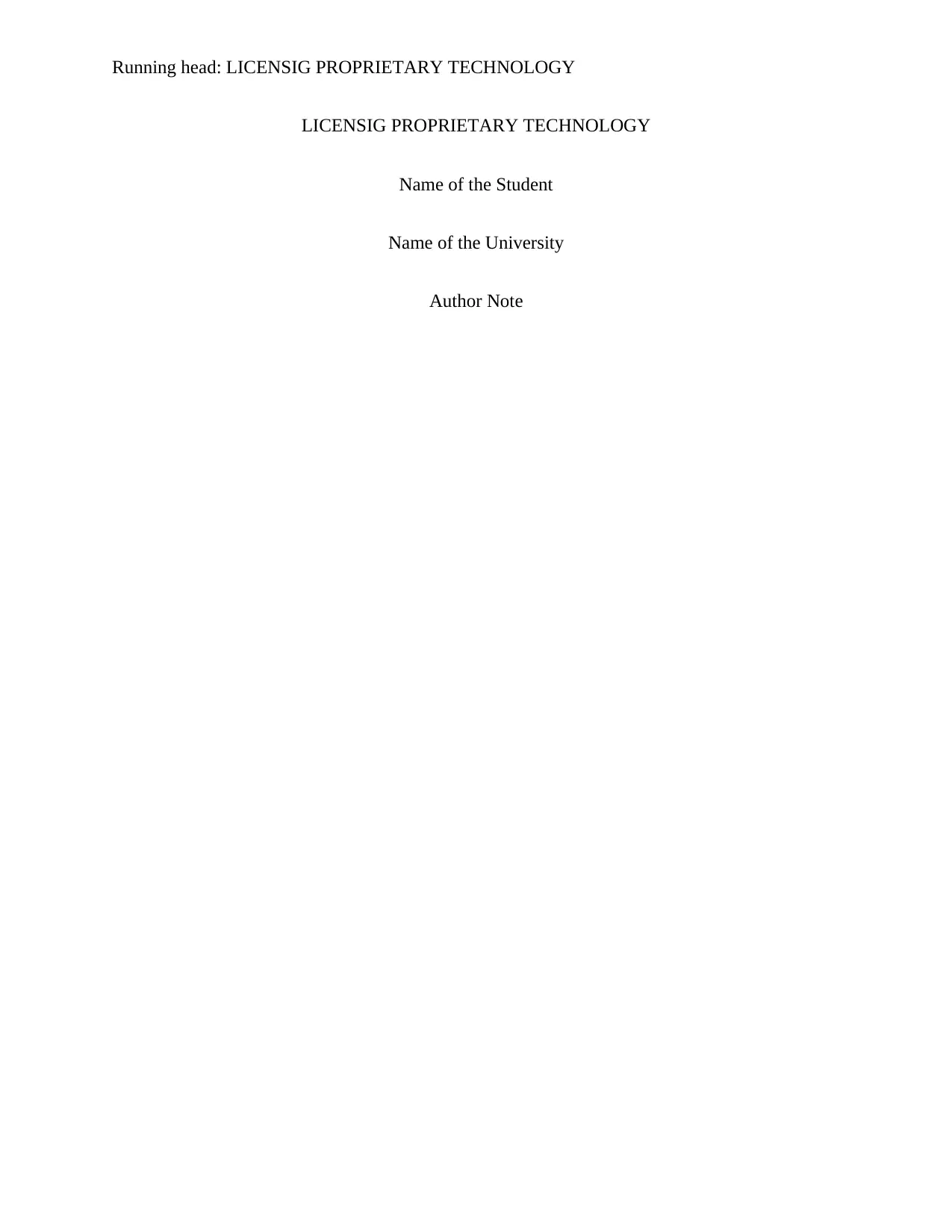
Running head: LICENSIG PROPRIETARY TECHNOLOGY
LICENSIG PROPRIETARY TECHNOLOGY
Name of the Student
Name of the University
Author Note
LICENSIG PROPRIETARY TECHNOLOGY
Name of the Student
Name of the University
Author Note
Paraphrase This Document
Need a fresh take? Get an instant paraphrase of this document with our AI Paraphraser
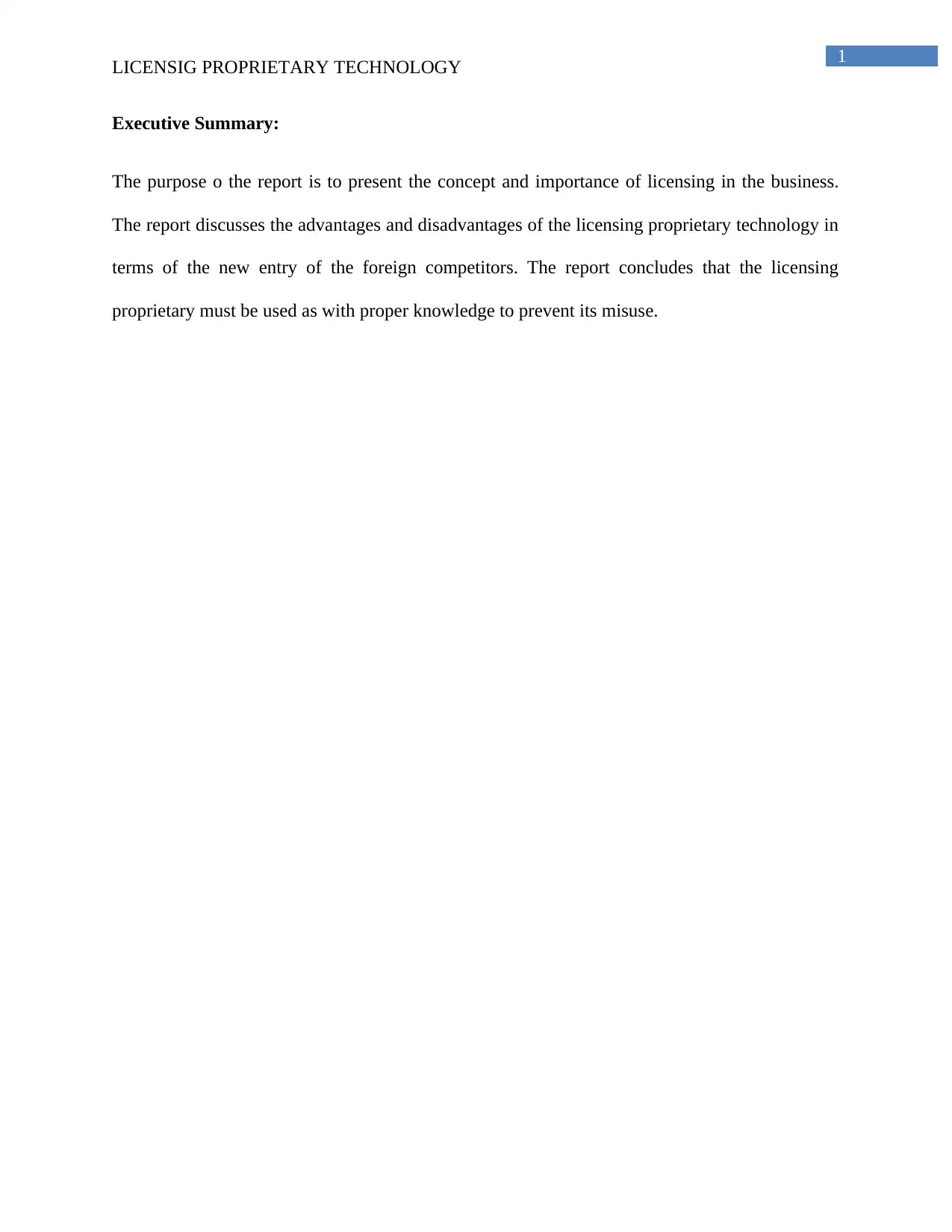
1
LICENSIG PROPRIETARY TECHNOLOGY
Executive Summary:
The purpose o the report is to present the concept and importance of licensing in the business.
The report discusses the advantages and disadvantages of the licensing proprietary technology in
terms of the new entry of the foreign competitors. The report concludes that the licensing
proprietary must be used as with proper knowledge to prevent its misuse.
LICENSIG PROPRIETARY TECHNOLOGY
Executive Summary:
The purpose o the report is to present the concept and importance of licensing in the business.
The report discusses the advantages and disadvantages of the licensing proprietary technology in
terms of the new entry of the foreign competitors. The report concludes that the licensing
proprietary must be used as with proper knowledge to prevent its misuse.
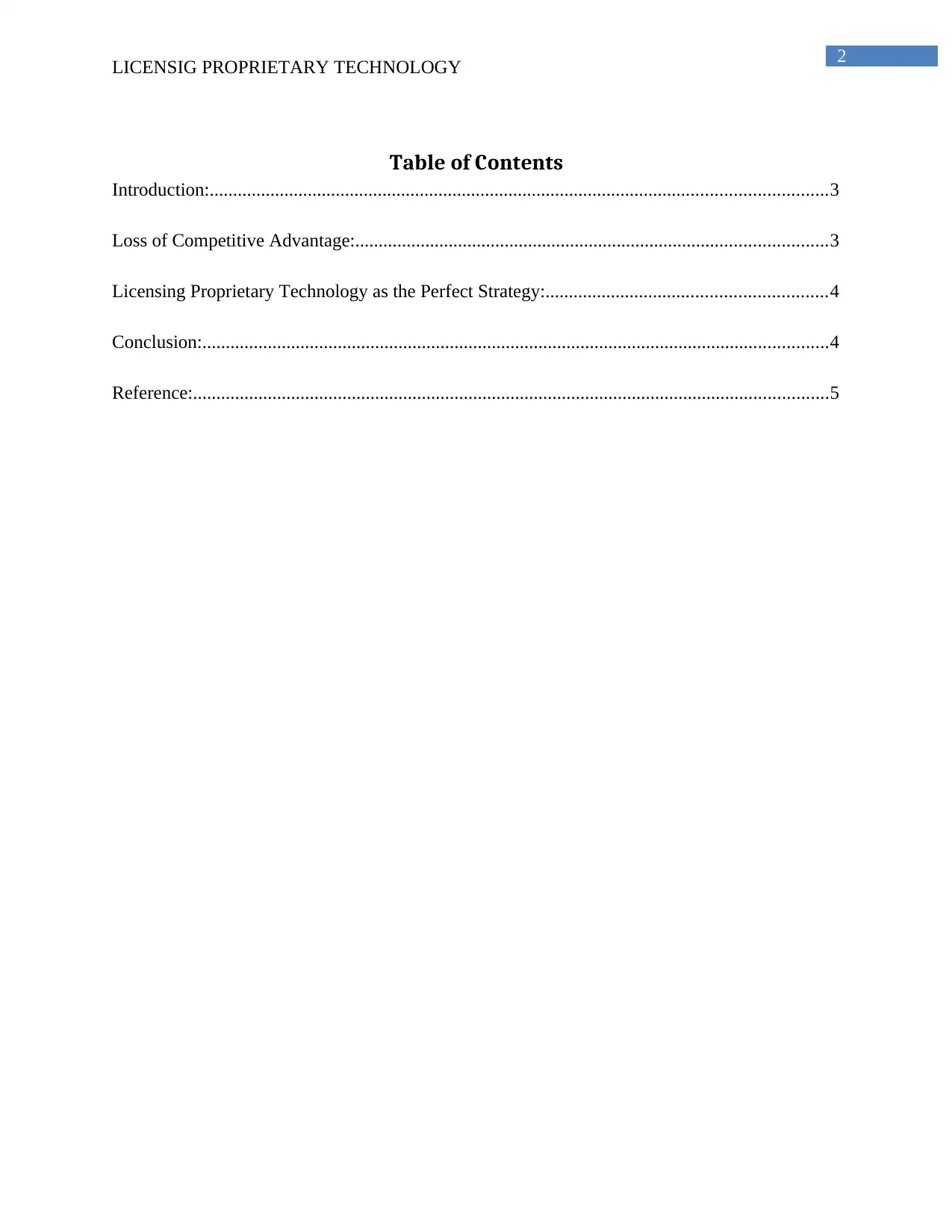
2
LICENSIG PROPRIETARY TECHNOLOGY
Table of Contents
Introduction:....................................................................................................................................3
Loss of Competitive Advantage:.....................................................................................................3
Licensing Proprietary Technology as the Perfect Strategy:............................................................4
Conclusion:......................................................................................................................................4
Reference:........................................................................................................................................5
LICENSIG PROPRIETARY TECHNOLOGY
Table of Contents
Introduction:....................................................................................................................................3
Loss of Competitive Advantage:.....................................................................................................3
Licensing Proprietary Technology as the Perfect Strategy:............................................................4
Conclusion:......................................................................................................................................4
Reference:........................................................................................................................................5
⊘ This is a preview!⊘
Do you want full access?
Subscribe today to unlock all pages.

Trusted by 1+ million students worldwide
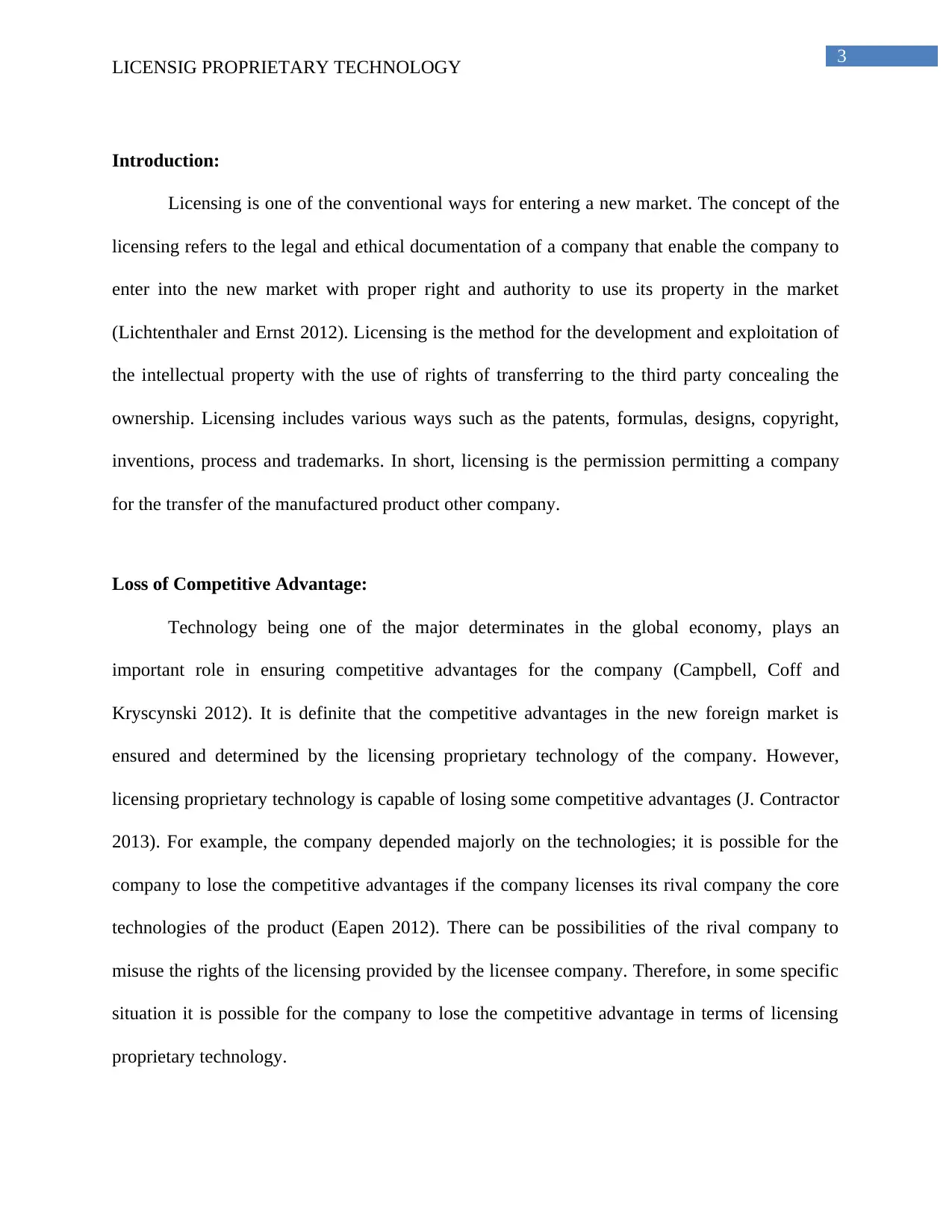
3
LICENSIG PROPRIETARY TECHNOLOGY
Introduction:
Licensing is one of the conventional ways for entering a new market. The concept of the
licensing refers to the legal and ethical documentation of a company that enable the company to
enter into the new market with proper right and authority to use its property in the market
(Lichtenthaler and Ernst 2012). Licensing is the method for the development and exploitation of
the intellectual property with the use of rights of transferring to the third party concealing the
ownership. Licensing includes various ways such as the patents, formulas, designs, copyright,
inventions, process and trademarks. In short, licensing is the permission permitting a company
for the transfer of the manufactured product other company.
Loss of Competitive Advantage:
Technology being one of the major determinates in the global economy, plays an
important role in ensuring competitive advantages for the company (Campbell, Coff and
Kryscynski 2012). It is definite that the competitive advantages in the new foreign market is
ensured and determined by the licensing proprietary technology of the company. However,
licensing proprietary technology is capable of losing some competitive advantages (J. Contractor
2013). For example, the company depended majorly on the technologies; it is possible for the
company to lose the competitive advantages if the company licenses its rival company the core
technologies of the product (Eapen 2012). There can be possibilities of the rival company to
misuse the rights of the licensing provided by the licensee company. Therefore, in some specific
situation it is possible for the company to lose the competitive advantage in terms of licensing
proprietary technology.
LICENSIG PROPRIETARY TECHNOLOGY
Introduction:
Licensing is one of the conventional ways for entering a new market. The concept of the
licensing refers to the legal and ethical documentation of a company that enable the company to
enter into the new market with proper right and authority to use its property in the market
(Lichtenthaler and Ernst 2012). Licensing is the method for the development and exploitation of
the intellectual property with the use of rights of transferring to the third party concealing the
ownership. Licensing includes various ways such as the patents, formulas, designs, copyright,
inventions, process and trademarks. In short, licensing is the permission permitting a company
for the transfer of the manufactured product other company.
Loss of Competitive Advantage:
Technology being one of the major determinates in the global economy, plays an
important role in ensuring competitive advantages for the company (Campbell, Coff and
Kryscynski 2012). It is definite that the competitive advantages in the new foreign market is
ensured and determined by the licensing proprietary technology of the company. However,
licensing proprietary technology is capable of losing some competitive advantages (J. Contractor
2013). For example, the company depended majorly on the technologies; it is possible for the
company to lose the competitive advantages if the company licenses its rival company the core
technologies of the product (Eapen 2012). There can be possibilities of the rival company to
misuse the rights of the licensing provided by the licensee company. Therefore, in some specific
situation it is possible for the company to lose the competitive advantage in terms of licensing
proprietary technology.
Paraphrase This Document
Need a fresh take? Get an instant paraphrase of this document with our AI Paraphraser
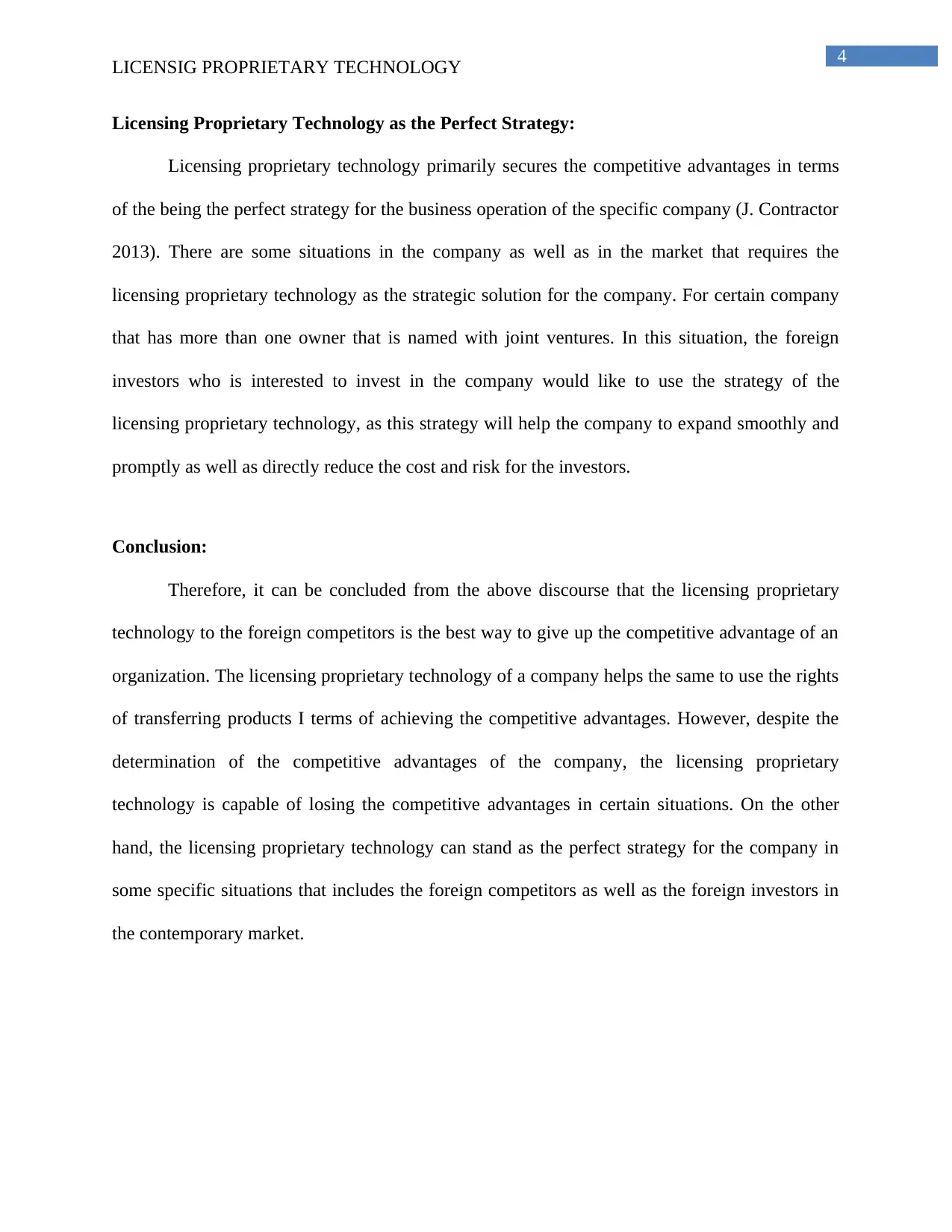
4
LICENSIG PROPRIETARY TECHNOLOGY
Licensing Proprietary Technology as the Perfect Strategy:
Licensing proprietary technology primarily secures the competitive advantages in terms
of the being the perfect strategy for the business operation of the specific company (J. Contractor
2013). There are some situations in the company as well as in the market that requires the
licensing proprietary technology as the strategic solution for the company. For certain company
that has more than one owner that is named with joint ventures. In this situation, the foreign
investors who is interested to invest in the company would like to use the strategy of the
licensing proprietary technology, as this strategy will help the company to expand smoothly and
promptly as well as directly reduce the cost and risk for the investors.
Conclusion:
Therefore, it can be concluded from the above discourse that the licensing proprietary
technology to the foreign competitors is the best way to give up the competitive advantage of an
organization. The licensing proprietary technology of a company helps the same to use the rights
of transferring products I terms of achieving the competitive advantages. However, despite the
determination of the competitive advantages of the company, the licensing proprietary
technology is capable of losing the competitive advantages in certain situations. On the other
hand, the licensing proprietary technology can stand as the perfect strategy for the company in
some specific situations that includes the foreign competitors as well as the foreign investors in
the contemporary market.
LICENSIG PROPRIETARY TECHNOLOGY
Licensing Proprietary Technology as the Perfect Strategy:
Licensing proprietary technology primarily secures the competitive advantages in terms
of the being the perfect strategy for the business operation of the specific company (J. Contractor
2013). There are some situations in the company as well as in the market that requires the
licensing proprietary technology as the strategic solution for the company. For certain company
that has more than one owner that is named with joint ventures. In this situation, the foreign
investors who is interested to invest in the company would like to use the strategy of the
licensing proprietary technology, as this strategy will help the company to expand smoothly and
promptly as well as directly reduce the cost and risk for the investors.
Conclusion:
Therefore, it can be concluded from the above discourse that the licensing proprietary
technology to the foreign competitors is the best way to give up the competitive advantage of an
organization. The licensing proprietary technology of a company helps the same to use the rights
of transferring products I terms of achieving the competitive advantages. However, despite the
determination of the competitive advantages of the company, the licensing proprietary
technology is capable of losing the competitive advantages in certain situations. On the other
hand, the licensing proprietary technology can stand as the perfect strategy for the company in
some specific situations that includes the foreign competitors as well as the foreign investors in
the contemporary market.
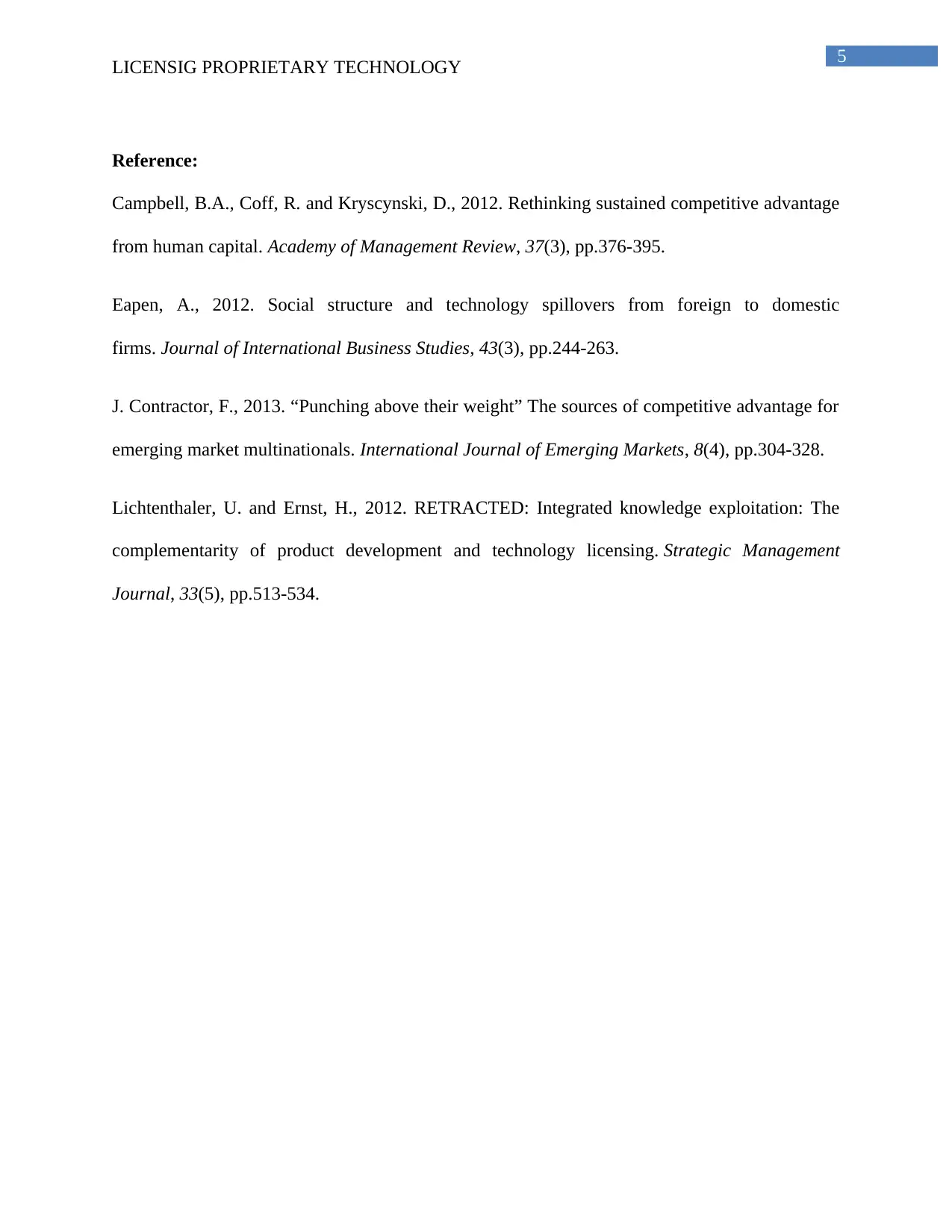
5
LICENSIG PROPRIETARY TECHNOLOGY
Reference:
Campbell, B.A., Coff, R. and Kryscynski, D., 2012. Rethinking sustained competitive advantage
from human capital. Academy of Management Review, 37(3), pp.376-395.
Eapen, A., 2012. Social structure and technology spillovers from foreign to domestic
firms. Journal of International Business Studies, 43(3), pp.244-263.
J. Contractor, F., 2013. “Punching above their weight” The sources of competitive advantage for
emerging market multinationals. International Journal of Emerging Markets, 8(4), pp.304-328.
Lichtenthaler, U. and Ernst, H., 2012. RETRACTED: Integrated knowledge exploitation: The
complementarity of product development and technology licensing. Strategic Management
Journal, 33(5), pp.513-534.
LICENSIG PROPRIETARY TECHNOLOGY
Reference:
Campbell, B.A., Coff, R. and Kryscynski, D., 2012. Rethinking sustained competitive advantage
from human capital. Academy of Management Review, 37(3), pp.376-395.
Eapen, A., 2012. Social structure and technology spillovers from foreign to domestic
firms. Journal of International Business Studies, 43(3), pp.244-263.
J. Contractor, F., 2013. “Punching above their weight” The sources of competitive advantage for
emerging market multinationals. International Journal of Emerging Markets, 8(4), pp.304-328.
Lichtenthaler, U. and Ernst, H., 2012. RETRACTED: Integrated knowledge exploitation: The
complementarity of product development and technology licensing. Strategic Management
Journal, 33(5), pp.513-534.
⊘ This is a preview!⊘
Do you want full access?
Subscribe today to unlock all pages.

Trusted by 1+ million students worldwide
1 out of 6
Related Documents
Your All-in-One AI-Powered Toolkit for Academic Success.
+13062052269
info@desklib.com
Available 24*7 on WhatsApp / Email
![[object Object]](/_next/static/media/star-bottom.7253800d.svg)
Unlock your academic potential
Copyright © 2020–2025 A2Z Services. All Rights Reserved. Developed and managed by ZUCOL.





